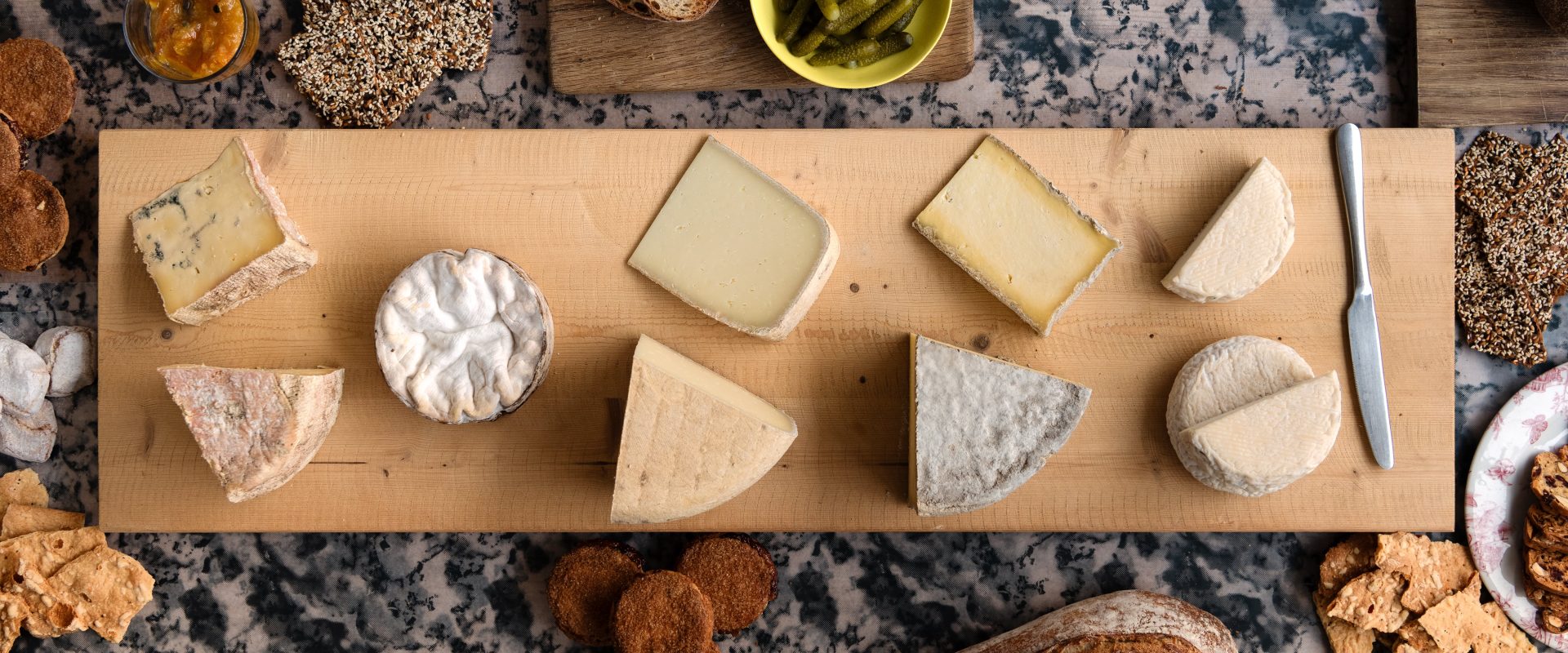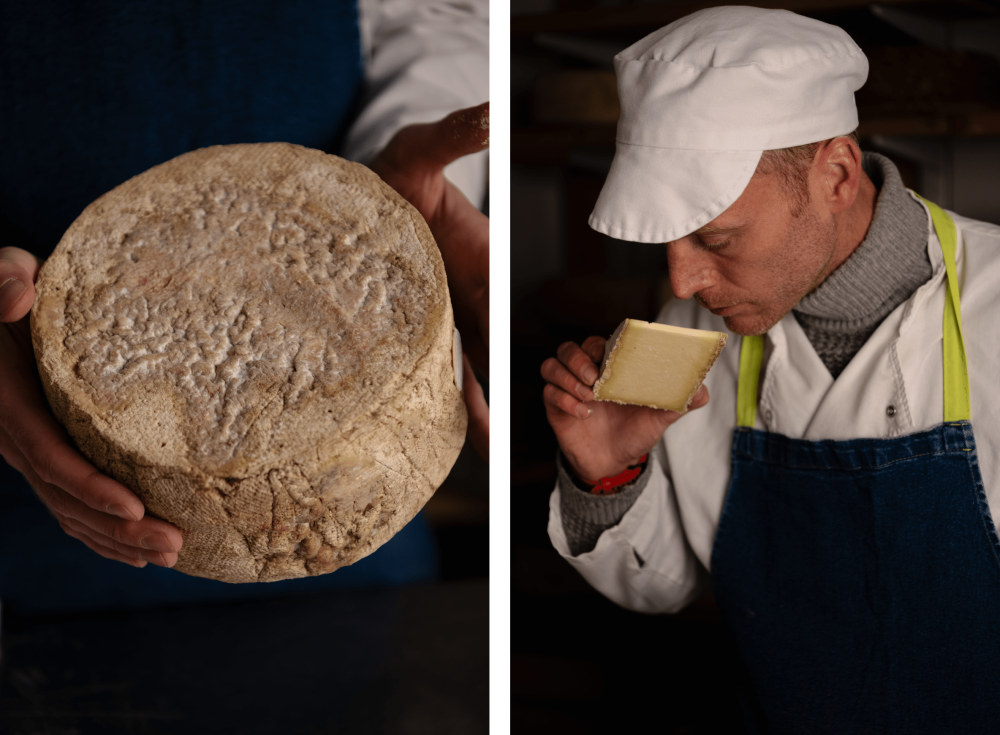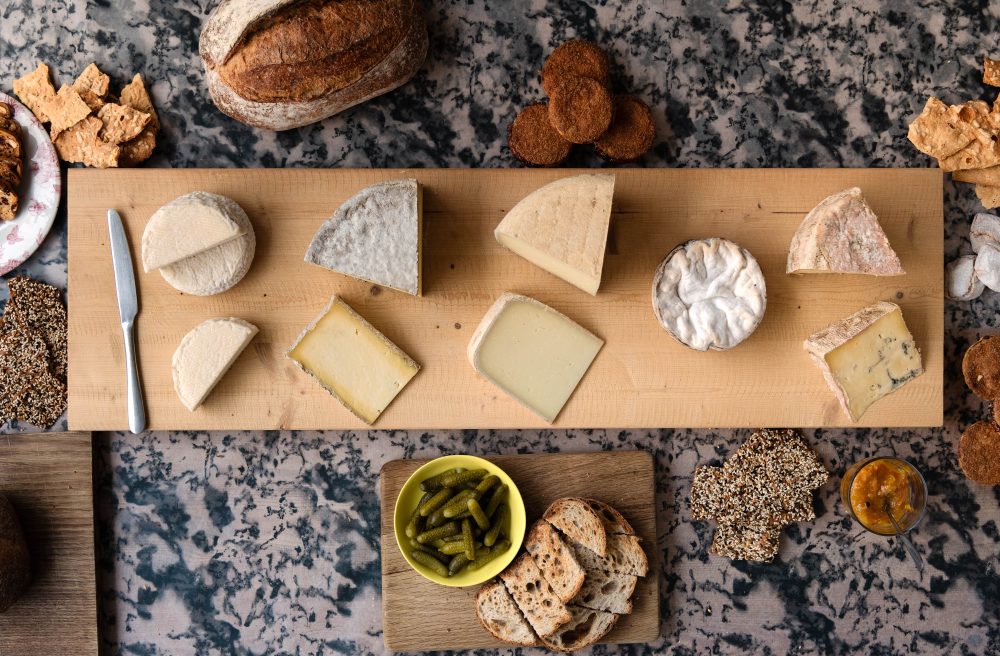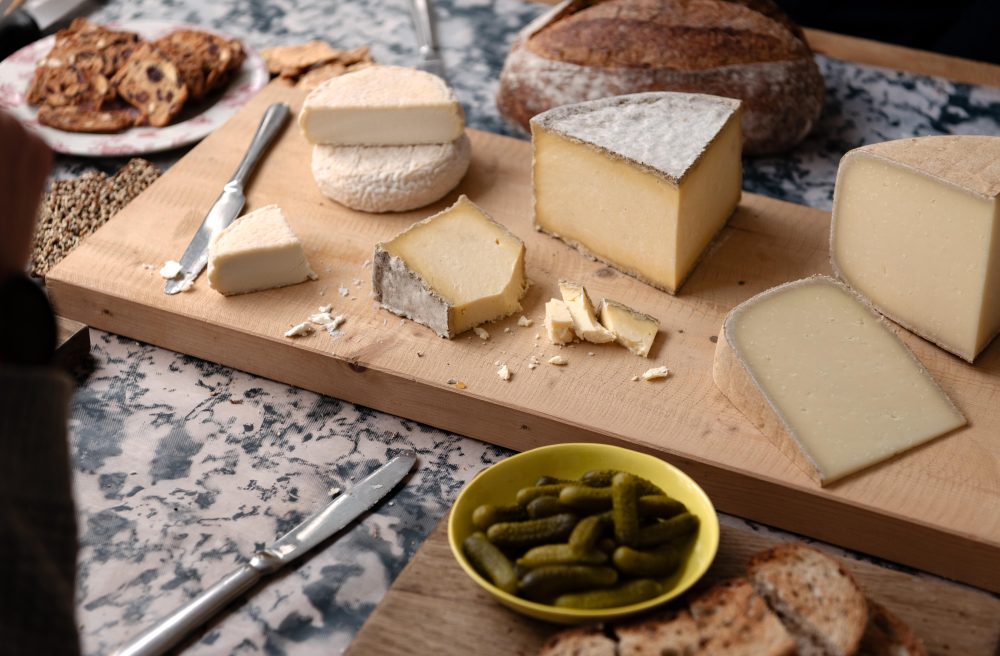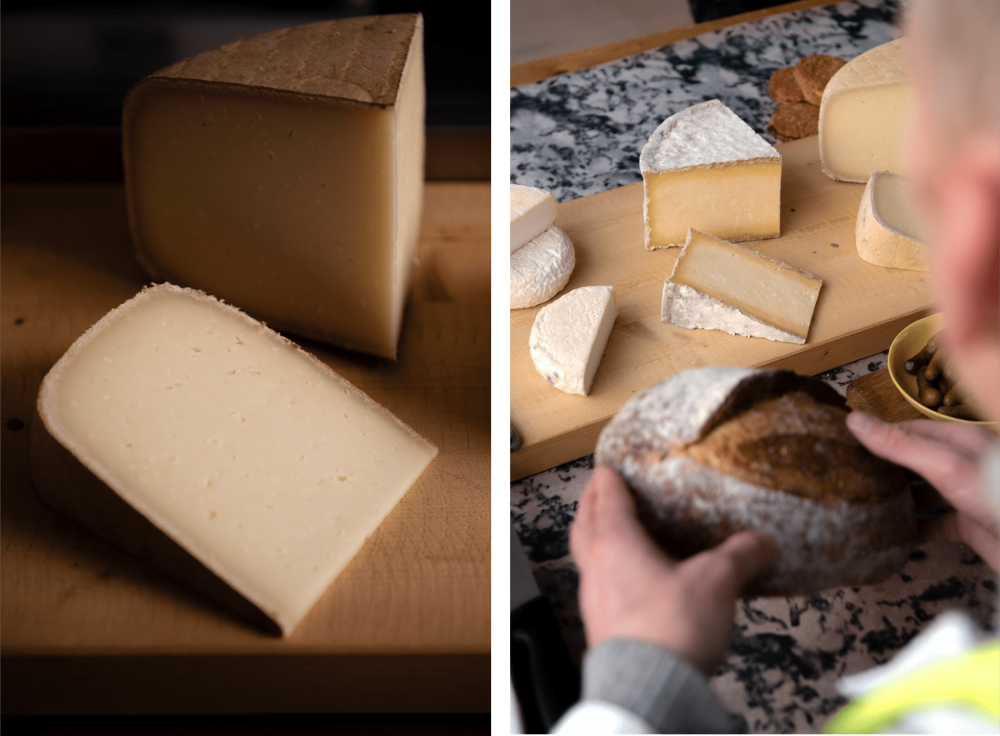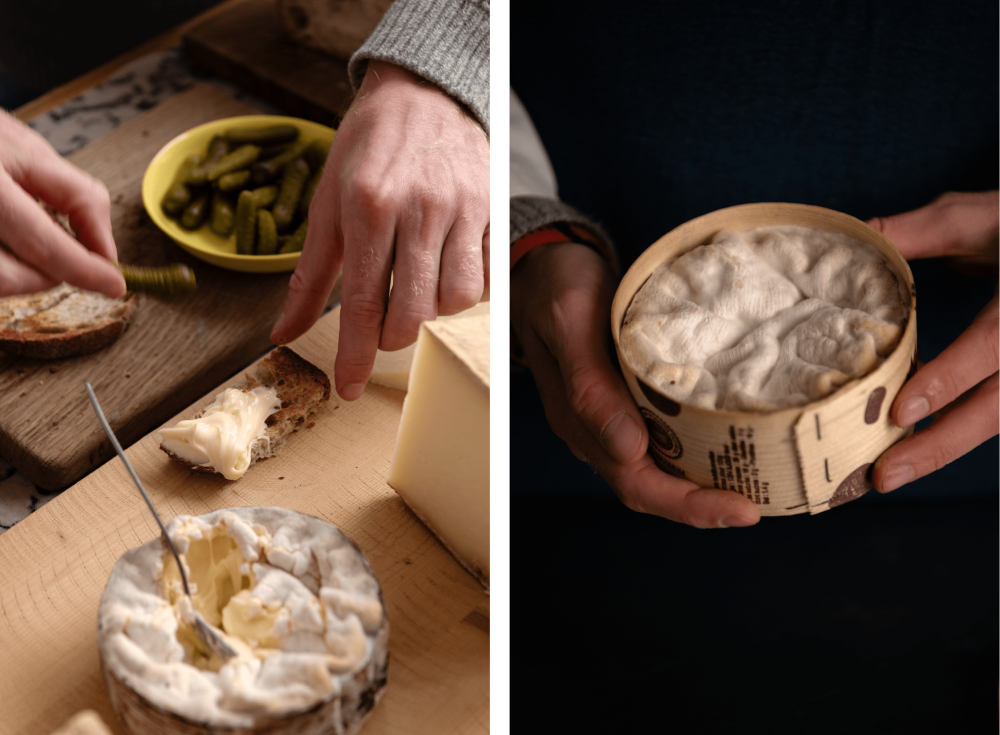Words Charlie Monaghan
Photography Elliot Sheppard
This Christmas season, we’re giving the gift of baking to our suppliers and partners and, in return, they are kindly sharing original festive recipes for you to try at home. Our first visit was to Lincolnshire Poacher dairy for a chutney recipe, and, here, we’re following on with something that will complement it well: we gift our cheesemonger, Rhuaridh Buchanan, bread, crackers and mince pies, which he incorporates into the perfect cheeseboard for the festive season.
Pictured above, from left: Rhuaridh Buchanan in his ageing rooms where cheeses from all over Britain and Europe come to finish their ageing under his care. Wheels of cloth-bound Sparkenhoe Red Leicester.
“I’ve just always loved cheese. I didn’t realise it was weird until later, but my after-school treat when I was a kid was a selection of cheeses and maybe some charcuterie,” says Rhuaridh Buchanan, providing perhaps the best answer to “How did you get into cheese?” we could have hoped for. We’re in Connaught Village at his shop Buchanans Cheesemonger, comprising a retail cheesemonger, ageing rooms, and the headquarters of his wholesale business, which supplies restaurants in London with artisanal British and European cheeses. Rhuaridh also happens to be our cheesemonger.
To say that we buy cheese from Buchanan is a bit like saying one buys a suit from a tailor. There are lots of off-the-peg options when it comes to sourcing cheese for our savoury bakes, but for a custom fit and customer service done the old-fashioned way, we go to Rhuaridh. That’s because his intimate knowledge of British and European artisanal cheesemakers, with whom he is in constant and close conversation, opens up opportunities that would otherwise be unknown.
Take, for example, this year’s Christmas croissant, for which we wanted a soft, melty British cheese. It was Rhuaridh, knowing the capabilities of Fen Farm Dairy and their Baron Bigod, who suggested they modify their standard recipe to use a vegetable-based rennet in a special vegetarian-friendly batch just for us. It’s a similar story with Quicke’s; Rhuaridh figured out Mary’s Devonshire Red, made with a vegetable-based rennet, would be perfect in our summer savouries this year. Our introduction to Lincolnshire Poacher, which we use on our ham and cheese croissant, meanwhile, also came by way of Rhuaridh.
“I’ve just always loved cheese”
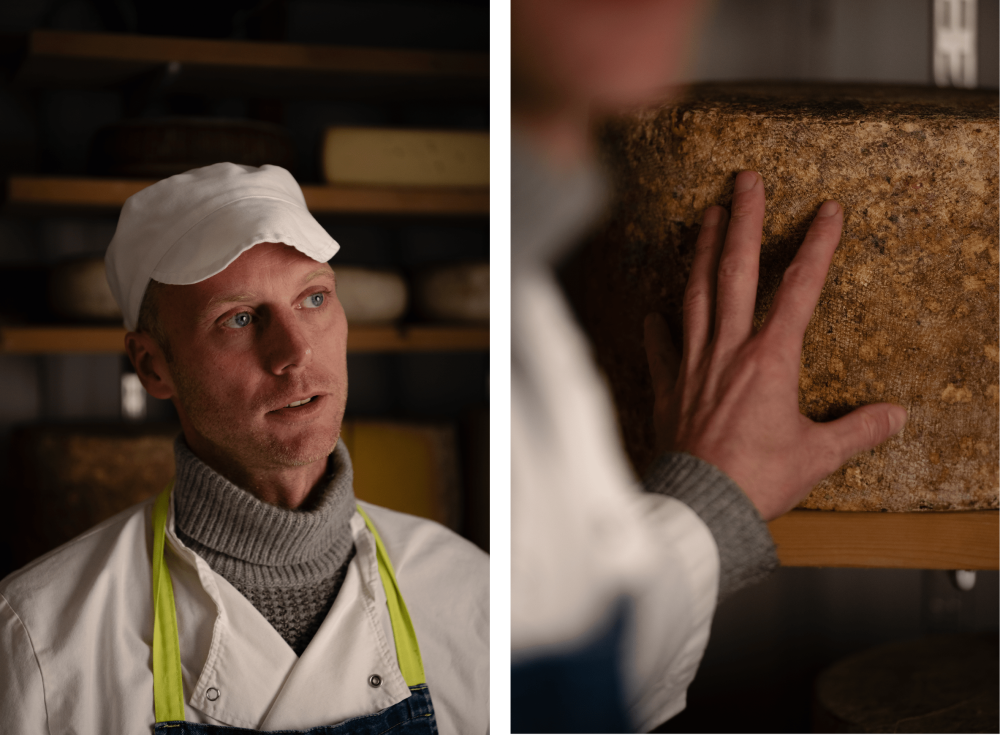
Pictured above: “I am most proud of the variety of cheese we have,” says Rhuaridh. The two bottom images show a wheel of Gorwydd Caerphilly being cut – the cheese, made in Somerset by the Trethowan Brothers, is the one Rhuaridh takes home the most.
“The cheese has to be delicious, that’s just a given”
Such matchmaking is only possible because of Rhuaridh’s experience working in the cheese industry for 20 years. After studying product design and working as a graphic designer for a couple of years, he went into hospitality after not being able to stand the thought he’d spend his working life at a desk. He ended up running the cheese trolley at a fine dining restaurant in Edinburgh, followed by stints at I. J. Mellis, Scotland’s preeminent cheesemonger, and then Paxton & Whitfield in London, where he ran the show for eight years.
In 2014 he set up Buchanans Cheesemonger to, as he puts it, “sell the best cheese I can get my hands on.” What makes him different from other mongers? “I think it’s customer service and attention to detail. I’ve always got one eye open when I’m at dairies and talking to producers, and then matching that with what I know my customers either like or are looking for.” It’s a service that many of his clients have come to depend on and trust implicitly; “Many of the restaurants I work with don’t specify what cheese they want, they just order by weight, knowing I’ll pick things that will suit their menus and way of cooking,” Rhuaridh explains before adding, “And, of course, the cheese has to be delicious, that’s just a given.”
“Our cheeses are a reflection of a moment in time.”
As for his own preferences, Rhuaridh has long had a proclivity towards hard, Alpine-style cheeses, but his tastes are wide-ranging. The one thing that does unite his cheeses is that almost all are made with unpasteurised, unhomogenised milk from animals that are pasture-fed. “Our cheeses are a reflection of a moment in time. Everything that happened on the day the cheese was made, from the weather to the animal’s feed, is captured in the end result,” Rhuaridh explains. Does he have a favourite, though? “I get asked that question at least three times a week and I have no way of answering other than saying what I bring home the most, which is Gorwydd Caerphilly. It’s just a great one to nibble on.”
It’s high praise because at his shop Rhuaridh has an enviable array to choose from. His ageing rooms are packed full of hard and soft varieties, carefully prepared and positioned to mature in specific ways. It’s another layer of trust he has garnered over the years, not from customers but the cheesemakers themselves, who hand over a major part of the cheese’s final texture and flavour development to him. “It’s all about making a conscious decision about the outcome we want when the young cheeses come to us, and knowing how to manage the ageing so you end up with that outcome.” If that sounds straightforward, the unpasteurised cheeses Buchanans Cheesemonger works with, and the variations that come with them, preclude a standardised approach. “It’s all by sense and feel; there is no fixed timetable,” he explains.
Making things more challenging is the limited space of a central London Victorian shopfront Rhuaridh works within. But things are changing. “We’re taking the unit next door and knocking through, which will double the shop space and ageing rooms. We’re going to go into the vaults under the street, which will mean we’re able to age soft and hard cheeses separately.” It’s a busy time, and not least because Christmas is coming. “People are just a bit more indulgent at this time of year and so maybe they are more prone to having the extra cheese course in a restaurant, or buying a bit more to have with a glass of port when friends come over,” Rhuaridh posits. With that in mind, below we’ve asked him to share his tips for cheese buying and serving over the festive season, as well as his take on the perfect selection.
Rhuaridh’s festive cheese tips
Pick three to five cheeses
“Less is more. Hard, soft, blue is a good approach, or hard, soft, goat. Or maybe you get five things and you use two or three at a time. However many you buy, aim for a balanced mix, and something that suits everyone. You don’t want all the cheeses to be super challenging; it’s quite nice to have something people are familiar with, like a Montgomery cheddar or a Comté.”
Buy large pieces, store them in the fridge and cut off the bit you need
“I advise people to buy fewer cheeses in bigger pieces as they’ll keep better that way. Cheese doesn’t like yo-yoing between temperatures, so store the pieces in the fridge and cut off what you need as you go.”
A bit of mould is no bad thing
“Cheese is mould, so a bit that develops on the surface is no bad thing – just cut it off.”
Cheese can be a meal…
“One of the British territorial cheeses like a Lancashire or Cheshire works well on a board but can also be served as a meal with a bit of ham and a hard-boiled egg. Or you can put a Mont d’Or on the table with baguettes, pickles, cornichons and maybe some charcuterie if you want something more substantial.”
…but you also don’t need to serve cheese with anything
“What I serve with cheese depends on the season but also the time of day. If I was having a bit of cheese for lunch, I would probably put bread out. But after a meal in the evening I would just serve some crackers, more to add some textural variation as opposed to filling up. Personally, I like to eat cheese without anything else!”
Rhuaridh’s festive cheeseboard
From right to left: Robiola, Gorwydd Caerphilly, Ossau Iraty, Mont d’Or, Pevensey Blue
1. Robiola
“This is a cheese we spent a long time sourcing, and it involved multiple trips to Piedmont, which was a right bummer! No one else is importing this to the UK. The protected cheese in the area is Robiola di Roccaverano D.O.P., and there are only 14 small producers making it in the mountains. It has to be made with pure goat’s milk, which means it’s a little less stable, but the outcome when it’s right is just amazing.
“We work with a Swiss family, the parents of which moved in the 1970s to the idyllic hills of Piedmont to make cheese. It arrives to us when it’s a couple of days old and we finish it here for about six weeks, depending on the batch. It’s such a beautiful cheese: fresh, simple, and versatile. Really delicious.”
Pair with: seeded crackers and pickled oranges
Pictured above: the Gorwydd Caerphilly is in the middle. Its yellowish hue is a sign that the cows were feeding on pasture.
2. Gorwydd Caerphilly
“I take this home once a fortnight. It’s made by the Trethowan brothers in Weston Super Mare, Somerset, where there is a long history of making Caerphilly. What I like about it is that you get three cheeses in one: there’s the lovely softer yoghurty bit in the middle, and then where we’ve aged it on it’s a bit more broken down, with a much more savoury, forest floor-like aroma. Then, you get this delicious suede-like rind, and it just adds a bit of texture to the whole thing. I think it sums up in one go what British cheese is, which I would say is generally more understated but no less exciting than European ones.”
Pair with: crusts of sourdough bread
3. Ossau Iraty
“This is a cheese made with sheep’s milk and is best enjoyed at around six months old. It’s got that dense mountain texture, with a slight spring to it. It’s a cheese that’s easy to enjoy; it’s sweet, nutty, and fudgy – this will absolutely go home with me at Christmas.
“It also takes well to a lot of Christmasy flavours that are around. The classic accompaniment to this is cherries in the summer, or cherry compote in the winter. Cherries aren’t seasonal in the winter but there is something about berries, maybe preserved or dried, as well as the spices and flavours that are around at Christmas, that would go really well with it.”
Pair with: fruit crackers
4. Mont d’Or
“This is a seasonal cheese made in autumn and winter; we get them in early October. It’s made from milk which is usually used to make Comté in the summer months, when the cows produce premium milk as they go up the mountain to eat fresh pasture.
“In the winter they are down in the valley. Some Comté is still made in the winter, but not the top-quality stuff. Instead, a quick maturing cheese is made that is soft and oozy – it’s liquid inside. We age it for about six weeks and in that time a lovely perfume is imbued into the cheese from the spruce wood it’s wrapped in. Christmas wouldn’t be Christmas without one of them on the table.”
Pair with: sourdough bread and cornichons
5. Pevensey Blue
“This is an excellent cheese made by Martin and Hazel Tkalez down in East Sussex. They’ve only been making cheese for a few years actually, originally taking inspiration from gorgonzola, but they’ve making something quite distinct now.
“It’s got a really lovely dense, fudgy texture, and a pepperiness to the flavour. The rich yellowy, golden ochre colours are a sign that the animal was on pasture. In the winter it will be paler when they’re on feed, so the colour of the cheese will change throughout the year.”
Pair with: mince pies
